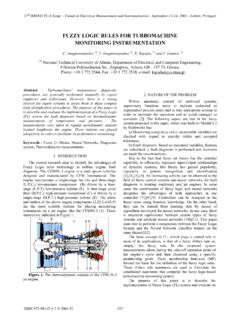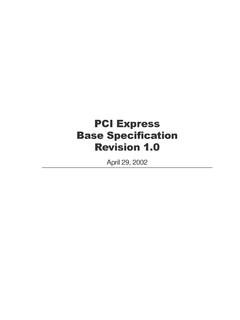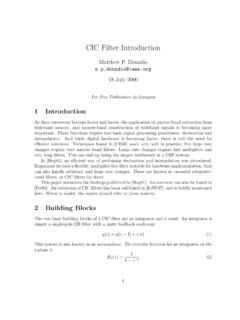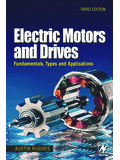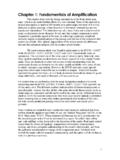Transcription of PRINCIPLES OF ELECTRICAL MEASUREMENT
1 PRINCIPLES OF ELECTRICAL MEASUREMENT Sensors SeriesSenior Series Editor: B E Jones Series Co-Editor: W B Spillman, Jr Novel Sensors and SensingR G JacksonHall Effect Devices, second edition R S Popovi cSensors and their Applications XII Edited by S J Prosser and E LewisSensors and their Applications XI Edited by K T V Grattan and S H KhanThin Film Magnetoresistive SensorsS TumanskiElectronic Noses and Olfaction 2000 Edited by J W Gardner and K C PersaudSensors and their Applications X Edited by N M White and A T AugoustiSensor MaterialsP T Moseley and J CrockerBiosensors: Microelectrochemical Devices M Lambrecht and W SansenCurrent Advances in SensorsEdited by B E JonesPRINCIPLES OFELECTRICAL MEASUREMENTS TumanskiWarsaw University of TechnologyWarsaw, PolandNew York LondonSeries in SensorsPublished in 2006 byCRC PressTaylor & Francis Group 6000 Broken Sound Parkway NW, Suite 300 Boca Raton, FL 33487-2742 2006 by Taylor & Francis Group, LLCCRC Press is an imprint of Taylor & Francis GroupNo claim to original Government worksPrinted in the United States of America on acid-free paper10987654321 International Standard Book Number-10: 0-7503-1038-3 (Hardcover) International Standard Book Number-13: 978-0-7503-1038-3 (Hardcover) Library of Congress Card Number 2005054928 This book contains information obtained from authentic and highly regarded sources.
2 Reprinted material isquoted with permission, and sources are indicated. A wide variety of references are listed. Reasonable effortshave been made to publish reliable data and information, but the author and the publisher cannot assumeresponsibility for the validity of all materials or for the consequences of their part of this book may be reprinted, reproduced, transmitted, or utilized in any form by any electronic,mechanical, or other means, now known or hereafter invented, including photocopying, microfilming, andrecording, or in any information storage or retrieval system, without written permission from the publishers. For permission to photocopy or use material electronically from this work, please access ( ) or contact the Copyright Clearance Center, Inc.
3 (CCC) 222 Rosewood Drive,Danvers, MA 01923, 978-750-8400. CCC is a not-for-profit organization that provides licenses and registrationfor a variety of users. For organizations that have been granted a photocopy license by the CCC, a separatesystem of payment has been arranged. Trademark Notice: Product or corporate names may be trademarks or registered trademarks, and are used onlyfor identification and explanation without intent to of Congress Cataloging-in-Publication DataTumanski, of ELECTRICAL MEASUREMENT / by Slawomir (Series in sensors)Includes bibliographical references and 0-7503-1038-31. Electric measurements. 2. Electronic measurements. 3. Signal processing. I. Title. II. Sensors the Taylor & Francis Web site at the CRC Press Web site at & Francis Group is the Academic Division of Informa Page 1 Wednesday, November 23, 2005 1:02 PMContentsPreface ix 1.
4 Introduction to Measurements 12. fundamentals of ELECTRICAL Measurements Main Terms and Definitions 13 Basic terms of MEASUREMENT technique 13 The main methods of measurements Uncertainty of Measurements 26 Errors, uncertainty, and reliability of signal processing 26 Basic statistical terms and concepts 34 Methods of evaluation and correction of the uncertainty related to limited accuracy of measuring devices 40 The estimation of uncertainty in measurements Standards of ELECTRICAL Quantities 57 Standards, etalons, calibration and validation 57 The standards of ELECTRICAL quantities referred to the physical phenomena and laws 58 Material standards of ELECTRICAL quantities 63 The reference multimeters and calibrators 69 References 71 3.
5 Classic ELECTRICAL Measurements Indicating Measuring Instruments 73 Electromechanical instruments versus digital measuring systems 73 The moving coil meters 74 The moving iron meters 81 Electrodynamic meters wattmeters 82 Induction type watt-hour meters Recording and Displaying Measuring Instruments 88 fundamentals of oscilloscopes 88 Recorders and data storage devices Bridge Circuits 94 Balanced and unbalanced bridge circuits 94 Null-type DC bridge circuits 96 VPRINCIPLES OF ELECTRICAL MEASUREMENTS VI The AC bridge circuits 99 The transformer bridge circuits 104 The unbalanced bridge circuits 107 The alternatives for bridge circuits Anderson Loop 112 Potentiometers and Comparators 114 References 118 4.
6 Processing of the Analogue MEASUREMENT Signals Signal Conditioning Analogue MEASUREMENT signals 121 Conditioning of resistance, capacitance and inductance 126 AC/DC conversion 131 Voltage to frequency conversion Amplification of the Signals 143 Differential, operational and instrumentation amplifiers 143 Isolation amplifiers 147 Amplifiers of very small DC signals 150 Amplifiers of very small AC signals 154 Amplifiers of very large input resistance (electrometers) 159 The function amplifiers Negative Feedback in the Measuring Technique The Improvement of the Quality of the Analogue Signals 179 The noises and interferences of the analogue signals 179 The connection of the measuring signal to the amplifier 184 The analogue filtering of the signals 191 References 201 5.
7 Digital Processing of the MEASUREMENT Signals 205 Analogue-to-Digital Converters 205 Sampling, quantization and coding of signals 205 Analogue-to-digital converters ADC 218 The main specifications of analogue-to-digital converters 234 Digital-to-Analogue Converters 238 The reconstruction of the analogue signal 238 The digital-to-analogue converters DAC 242 The main specifications of digital-to-analogue converters 247 Methods and Tools of Digital Signal Processing 249 The main terms of digital signal processing 249 The Discrete Fourier Transform DFT and Fast Fourier Transform FFT 259 Short-time Fourier Transform and Wavelet transform 268 Digital filters 275 CONTENTS Examples of Application of Digital Signal Processing in Measurements 287 The spectral analysis 287 Digital signal
8 Synthesis 297 Improvement of the signal quality and the signal recovery 303 Digital Measuring Instruments 312 Digital multimeters and frequency meters 312 Digital oscilloscopes 318 Digital MEASUREMENT of power and energy Intelligent Data Analysis 326 The artificial intelligence in measurements 326 The adaptive filters 327 Artificial neural networks 331 Fuzzy Logic 340 References 344 6. Computer Measuring Systems Introduction Input Circuits of the Measuring Systems 353 Circuits for data conditioning and acquisition 353 The sensors with built-in interface intelligent sensors 354 Analogue and digital transmitters 356 Data loggers 357 IEEE P1451 standard smart sensors Data Acquisition Circuits DAQ 362 Plug-in data acquisition board 362 External data acquisition board Data Communication in Computer Measuring Systems 367 Interfaces, buses and connectors 367 Serial interfaces: RS-232C and RS-485 368 Serial interfaces: USB and FireWire 373 Parallel GPIB interface (IEEE-488/IEC-625) 377 Wireless interfaces.
9 IrDA, Bluetooth and WUSB 382 Mobile telephony systems GSM and UMTS as a tool for data transfer 385 Radio data acquisition and transfer 389 Computer systems using Ethernet and Internet 392 Dedicated interfaces: CAN, I2C, MicroLAN, SDI-12 396 HART interface and the 4 20 mA standard 400 Industrial communication standards Fieldbus, Profibus, SCADA 401 Modular systems VXI, PXI 406 Standard command for measuring devices SCPI 408 PRINCIPLES OF ELECTRICAL MEASUREMENTS Measuring Systems Basing on the Signal Processors 410 Microcontrollers and signal processors in measuring technique 410 Microinterfaces SPI and UART Virtual Measuring Systems 421 What is the virtual measuring device? 421 TestPoint 424 Agilent VEE Pro 428 LabVIEW of National Instruments The Examples of Computer Measuring Systems 438 The measuring system for testing of magnetic materials 438 The arbitrary wave excitation systems 442 The scanning device for magnetic field imaging 449 References 452 Symbols used in the Book 455 Abbreviations used in the Book 457 Index 461 PrefaceIn libraries and bookshops we can
10 Find various books on ELECTRICAL measurements1. Most of them describe various aspects of ELECTRICAL measurements: digital or analogue techniques, sensors, data acquisition, data conversion, etc. However, it can be difficult to find a book that includes a complete guide on the techniques used in taking ELECTRICAL measurements. The reason for this is rather obvious modern measuring requires knowledge of many interdisciplinary topics such as computer techniques, electronics, signal processing, micro- and nanotechnology, artificial intelligence methods, etc. It is practically impossible for one author to know and explain all these subjects. Therefore, there are frequently available books called Handbook written by dozens of co-authors. Unfortunately, such books are mainly more conglomerates of many encyclopaedia entries of unequal levels than comprehensive and compact knowledgeable books.
